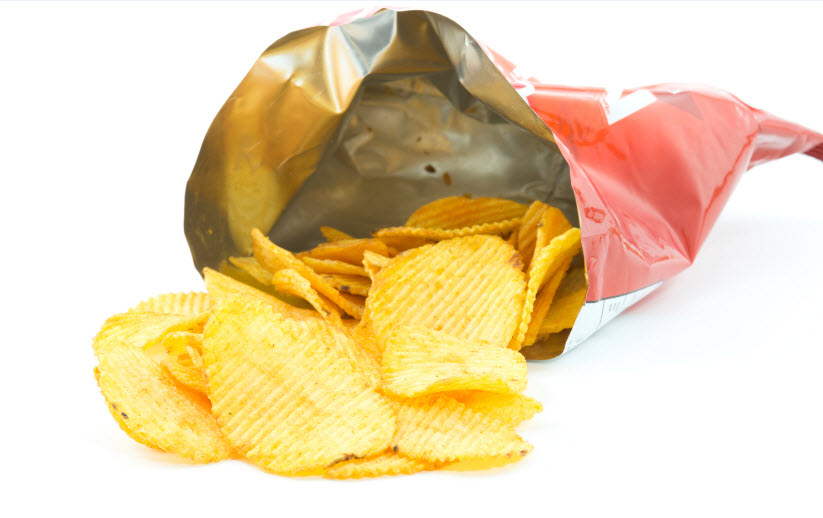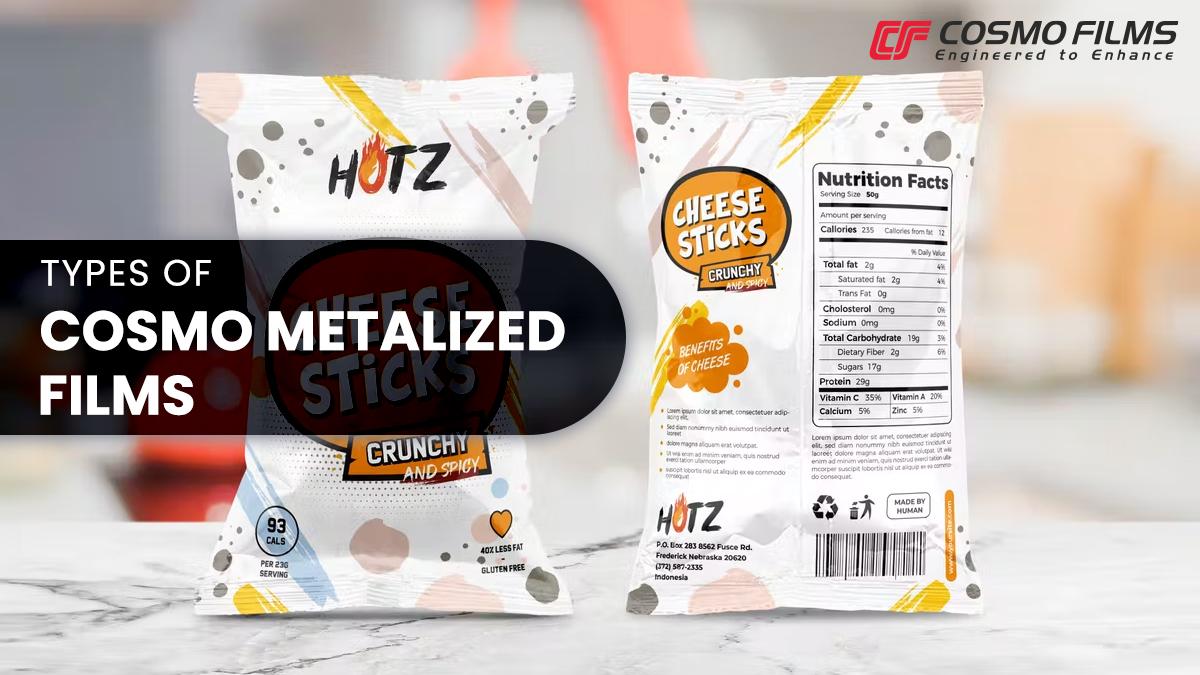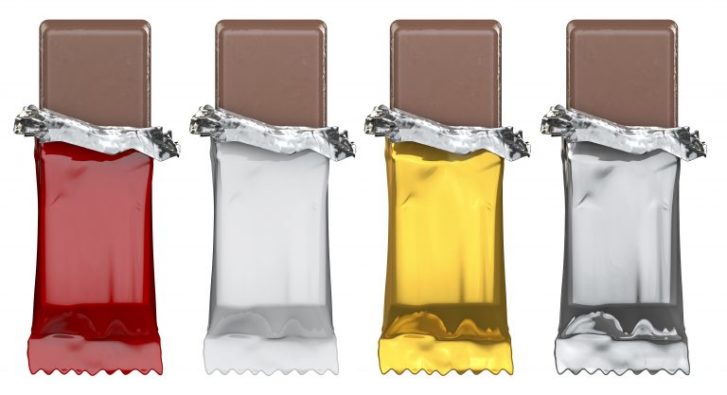What Types of Metalized Films Are Used in Snack Food Packaging and What Are Their Key Properties?

Metalized films have become a key choice in snack food packaging. They enhance product protection, maintain freshness, and help brands stand out on the shelf. Let’s break down what these films are, how they work, and why they are widely used in snack packaging.
What are Metalized Films and How Are They Manufactured for Snack Packaging?
Metalized films are plastic films coated with a thin layer of metal, usually aluminum. This metal layer is so thin that it’s often invisible to the eye but highly effective. The coating process is done in a vacuum chamber, where aluminum vapor condenses on the plastic film. This adds a reflective, shiny surface that also boosts barrier properties.
The base films are typically plastic types like PET (polyethylene terephthalate) or OPP (oriented polypropylene). The metal layer makes the film resist moisture, oxygen, oils, and light — all factors that can spoil snacks.
The manufacturing process usually involves two steps:
- Film extrusion or casting: Creating a clear or oriented plastic film base.
- Vacuum metalizing: Placing the plastic film in a chamber where aluminum is vaporized and deposited evenly across its surface.
This method produces a lightweight, flexible film that can be made in large rolls for easy converting into snack bags.
Most Common Metalized Film Types Used in Snack Food Packaging
Several metalized film types are popular in snack food packaging. Each has unique features tailored to different needs.
- Metalized PET: Known for its high strength, stiffness, and excellent barrier against oxygen and moisture. It has a brilliant metallic appearance and is widely used where good printability and durability are required.
- Metalized OPP: This film is more flexible and has better seal strength than PET. Metalized OPP offers good moisture barrier but slightly lower oxygen barrier. It’s often used for crisps and snacks needing flexible packaging.
- Other types: Metalized nylon and metalized biaxially oriented polypropylene (BOPP) are also used, especially in multilayer laminates for improved puncture resistance or for specific sealing needs.
Here’s a simple comparison table:
| Film Type | Barrier Strength | Flexibility | Common Use | Printability |
|---|---|---|---|---|
| Metalized PET | High oxygen & moisture | Medium | Stand-up pouches, snack bags | Excellent |
| Metalized OPP | Moderate moisture & oxygen | High | Crisps, confectionery | Good |
| Metalized Nylon | High puncture resistance | Medium | High barrier laminates | Fair |
How Metalized Films Improve Barrier Properties
Metalized films provide a crucial shield against factors that degrade snack quality.
- Moisture: The metal layer acts almost like a thin foil, stopping moisture vapor from entering or leaving the package. This keeps snacks crisp and prevents sogginess.
- Oxygen: Oxygen exposure causes spoilage and rancidity. Metalized films block oxygen, preserving flavor and freshness.
- Light: UV and visible light can degrade vitamins and fats. The reflective metal layer keeps light out.
- Odors: The barrier also stops external odors from penetrating and internal odors from escaping, maintaining product aroma.
The combination of plastic and metal achieves high barrier properties typical of aluminum foil but with less weight and better flexibility.
Differences in Sealing and Machinability of Metalized Films
Packaging machines for snack foods mainly use heat for sealing. Metalized films vary in how well they seal and how easy they are to run on machines like HFFS (Horizontal Form-Fill-Seal) and VFFS (Vertical Form-Fill-Seal).
- Sealing: Metalized OPP generally seals easier at lower temperatures compared to metalized PET, since PET needs higher heat for a strong seal.
- Machinability: Metalized OPP is more flexible and runs smoothly at higher speeds, ideal for crisp packets. Metalized PET, while strong, can be stiffer, which may require slower speeds or special equipment adjustments.
When these films are combined in multilayer laminates, manufacturers balance sealing ease, barrier needs, and machine compatibility.
Reflective and Print-Friendly Surfaces Enhance Product Attractiveness
The shiny, metallic surface of metalized films catches consumers’ eyes. This reflective finish:
- Draws attention on crowded shelves.
- Allows high-quality printing: Metalized PET and OPP accept various ink types like flexography, UV, and offset printing.
- Supports vibrant colors and crisp texts, reinforcing brand identity.
This makes snacks wrapped in metalized films look fresh, modern, and premium. Brands often use these films to deliver strong shelf impact.
Multilayer Laminate Variants Incorporating Metalized Films
To boost protection, metalized films are often combined with other layers in laminates. These multilayers target specific barrier challenges:
- Metalized PET + PE (polyethylene): Provides strong moisture and oxygen barrier with heat-sealable inner layer.
- Metalized OPP + CPP (cast polypropylene): Gives flexible sealing with moderate barrier, good for lightweight snacks.
- Triple-layer laminates: These may include a metalized film, a white or clear film for printability, and a sealant layer for machine compatibility.
Recent innovations also feature oxo-biodegradable coatings and solvent-free metalizing methods to reduce environmental impact while maintaining barrier effectiveness.
How Metalized Coatings Compare with Aluminum Foil Pouches
Metalized films often replace aluminum foil pouches for snacks, but each has pros and cons.
| Feature | Metalized Films | Aluminum Foil Pouches |
|---|---|---|
| Barrier | Good moisture, oxygen, light | Excellent moisture, oxygen, light |
| Weight | Lightweight | Heavier |
| Cost | Lower | Higher |
| Durability | Moderate | High |
| Print surface | Flexible and creative | Good but less flexible |
| Recycling | Tough due to mixed materials | Easier when separated but complicated by laminates |
For example, snacks requiring long shelf life may use aluminum foil, while crisps and cookies typically use metalized PET or OPP for cost-effectiveness and decent protection.
Answering Common Questions About Metalized Films in Snack Packaging
- What types are most common? Metalized PET and metalized OPP dominate snack packaging due to their excellent barrier and machinability.
- How do metalized films preserve snack quality? They block moisture, oxygen, light, and odors to keep snacks fresh and crunchy longer.
- What manufacturing processes are involved? Plastic film extrusion followed by vacuum metalizing creates metalized films fit for heat sealing and printing.
Understanding these facts helps you choose the right metalized film for any snack packaging application. It’s a blend of science and art—balancing protection, cost, production ease, and shelf appeal.
How Do Metalized Films Impact Food Safety and Quality Control in Snack Packaging?

When you examine specific metalized films used in snack food packaging, you quickly see their unique impact on food safety and quality control. Metalized films are very common in snack packaging because they protect products well and look attractive. But they also create some challenges for contaminant detection and inspection systems. I’ll break down these key points so you fully understand the role metalized films play in food safety.
Why Do Metalized Films Interfere With Traditional Metal Detectors?
Traditional metal detectors in food production work by sending out high-frequency radio waves (around 50–700 KHz). When those waves hit metal contaminants, the detector picks up changes and sounds an alarm.
But metalized films have a thin layer of aluminum. This thin metal layer reflects or absorbs the radio waves, confusing the detector.
Here’s why metal detectors struggle with metalized films:
- Metal layer in packaging causes signals similar to contaminants.
- The interference increases false alarms or masks real metal contaminants.
- The tight space in Vertical Form-Fill-Seal (VFFS) machines limits reject options.
- Workarounds like double-bagging or alarms do not fully fix the problem.
This means metal detectors are less reliable in ensuring food safety with metalized snack packaging.
How Do X-ray Inspection Systems Overcome These Challenges?
X-ray inspection systems take a different approach. Instead of relying on metal signals, they detect density differences inside the package.
Metalized films may have a thin metal layer, but X-rays easily pass through and focus on the packed snacks themselves.
Advantages include:
- Detects metals, bone fragments, stones, plastics, and other contaminants.
- Works well with metalized films since packaging metal does not block X-rays.
- Finds broken or missing pieces in bar-shaped snacks.
- Provides a primary defense line before products leave the factory.
Thus, X-ray inspection is the preferred system for snack food packaged in metalized films. It overcomes metal detector limitations by targeting the contents, not just metal signals.
What Advanced X-ray Techniques Are Used?
Two advanced X-ray technologies help inspect snacks inside metalized packaging:
| Technology | Description | Benefits |
|---|---|---|
| Material Discrimination X-Ray (MDX) | Analyzes different materials based on density and atomic number. | Separates organic and inorganic contaminants accurately. |
| Dual Energy X-Ray Absorptiometry (DEXA) | Uses two different X-ray energy levels to identify chemical composition. | Detects complex textures and compositions in snacks. |
These techniques boost contaminant detection accuracy. For example, DEXA can spot dense plastics hidden in potato chip bags.
What Additional Quality Assurance Checks Can X-ray Inspection Perform?
X-ray inspection does more than find contaminants. It also provides several vital quality checks in snack packaging:
- Mass Measurement: Confirms product weight matches label weight. Eliminates separate weighing machines.
- Fill Level Verification: Ensures bags are filled correctly, improving customer satisfaction.
- Seal Integrity: Compares grayscale X-ray images to standards to spot broken or incomplete seals.
- Missing Component Detection: Finds missing items like straws or instructions in multi-part snacks.
Together, these checks maintain consistent quality and protect brand reputation.
How Does Product Orientation and Packaging Design Affect Inspection?
The way snacks and packaging move through inspection affects detection accuracy.
- Metal detectors perform better with proper product orientation, but metalized films reduce this advantage.
- X-ray systems require optimization of package presentation (flat, standing, or horizontal) for best image clarity.
- Certain packaging styles (e.g., pouches or bags) may need specific calibration to avoid false positives.
- Packaging design that minimizes overlapping dense areas helps improve X-ray inspection effectiveness.
Manufacturers must optimize packaging design and inspection setup together to maintain quality control.
What Regulatory Requirements Apply to Metalized Film Snack Packaging?
Food safety authorities like the US FDA regulate contaminant detection and packaging standards.
- Snack food packaging must prevent contamination risks during handling and transport.
- Packaging must protect food from moisture, oxygen, and light to extend shelf life.
- Inspection methods, including X-ray, must reliably detect contaminants like metal, glass, and stones.
- Proper labeling for weight and contents is mandatory to avoid consumer deception.
Compliance with these standards is critical for legal market access and consumer trust.
How Do Metalized Films Help Extend Shelf Life and Prevent Contamination?
Metalized films add major benefits beyond safety inspection:
- The aluminum coating blocks moisture, oxygen, and odors better than clear films.
- This protective barrier slows spoilage, preserves crunch, and maintains flavor.
- The reflective surface shields snacks from UV light damage.
- The sturdy film reduces risk of physical contamination or damage during shipping.
Compared with clear plastic films, metalized films can extend snack shelf life by days or weeks, improving product freshness and reducing waste.
Quick Facts Table: Metal Detectors vs. X-ray Inspection in Metalized Snack Packaging
| Feature | Metal Detectors | X-ray Inspection |
|---|---|---|
| Detection Basis | Metal presence via radio frequency | Density differences inside package |
| Performance with Metalized Films | Poor; interference causes missed or false alarms | Excellent; metal layer does not affect detection |
| Contaminants Detected | Metals only | Metals, bone, plastics, stones, rubber |
| Additional Quality Checks | None | Mass, fill level, seal integrity, missing parts |
| Machinery Compatibility | Limited in VFFS machines due to space | Highly compatible and effective on all lines |
| Regulatory Acceptance | Standard but limited in metalized packaging | Increasingly preferred, FDA-approved technology |
Case Study: X-ray Inspection Improving Safety at a Snack Manufacturer
At a major potato chip plant, metal detector issues caused frequent false alarms due to metalized bags. Switching to X-ray inspection solved these problems. The X-ray system:
- Found contaminants metal detectors missed.
- Verified correct fill levels and weights.
- Detected seal faults before packaging reached customers.
- Reduced product waste by cutting false rejects.
This shift improved food safety compliance and customer satisfaction, while saving money.
By examining specific metalized films used in snack food packaging, it’s clear their effects on food safety stretch beyond protection. They challenge traditional metal detectors but unlock advanced inspection solutions like X-ray. This combination keeps snacks safe, fresh, and shelf-ready in today’s competitive markets.
What Are the Environmental, Cost, and Practical Considerations When Choosing Metalized Films for Snack Packaging?

When I examine specific metalized films used in snack food packaging, I find that choosing the right film means balancing environmental impact, cost, and practicality. Metalized films are popular because they create shiny, attractive snack bags with good barrier properties. But they bring some challenges we need to understand before deciding to use them.
Environmental Impact and Recyclability Challenges of Metalized Film Snack Packaging
Metalized films combine plastic layers with a very thin aluminum coating. This design blocks moisture, oxygen, and odors, which keeps snacks fresh longer. However, this mix of materials also makes recycling tricky.
The main issue is that the thin aluminum layer sticks tightly to plastic, so recycling plants struggle to separate the two. Most curbside programs do not accept metalized film packaging because it can contaminate the recycling stream. This leads to most used packages ending up in landfills or incinerators.
Some companies have started developing oxo-biodegradable metalized films. These films contain additives that help break down plastics with exposure to oxygen and light, speeding up their decay compared to regular plastics. While not a full recycling solution, oxo-biodegradability is a step towards reducing environmental harm.
Another innovation is the use of solvent-free coatings on metalized films. These coatings reduce the chemical load during manufacturing and can improve recyclability by enabling easier delamination of layers. Solvent-free coatings also reduce emissions in production, improving the environmental footprint.
| Challenge | Description |
|---|---|
| Mixed material layers | Aluminum and plastic closely bonded, difficult to separate |
| Limited recycling streams | Most curbside programs do not accept metalized films |
| Environmental persistence | Plastic components remain in landfill for decades |
| Innovations | Oxo-biodegradable films, solvent-free coatings improving decay/recycling |
Comparing Metalized Films and Aluminum Foil Pouches: Cost, Weight, and Durability
When comparing metalized films and aluminum foil pouches for snack packaging, cost and performance vary significantly.
- Cost: Metalized films generally cost less per unit because they use thinner metal layers and simpler plastics. The manufacturing process is streamlined since metallizing plastic is cheaper than producing pure aluminum foil and laminating it with plastics.
- Weight: Metalized films weigh less, which reduces shipping and handling costs. This makes them an attractive choice for large volumes of lightweight snacks like chips and nuts.
- Durability: Aluminum foil pouches outperform metalized films in puncture and tear resistance. Aluminum pouches provide a stronger, more rigid barrier that protects sensitive products better under rough transit conditions or long shelf life demands.
Because of these differences, metalized films are excellent for snacks needing good moisture and oxygen barriers but not extreme durability. Aluminum foil pouches suit products with very long shelf life needs or fragile contents, including pharmaceuticals and high-end food items.
| Feature | Metalized Films | Aluminum Foil Pouches |
|---|---|---|
| Cost | Lower | Higher |
| Weight | Lightweight | Heavier |
| Barrier | Good moisture and oxygen | Excellent moisture, oxygen, light |
| Durability | Moderate | High |
| Suitability | Snacks, dry foods | Sensitive perishables, pharmaceuticals |
Sustainability Innovations Improving Metalized Film Packaging
Many snack food brands are pushing for greener packaging. Innovations in metalized packaging are responding to this consumer demand:
- Oxo-biodegradable films: These break down faster under environmental conditions but still need proper waste management.
- Solvent-free coated metalized films: These reduce chemical waste and improve recyclability.
- Mono-material laminates: Some manufacturers are moving towards single-polymer metalized films to simplify recycling.
- Lightweight designs: Reducing film thickness saves materials and cuts down waste.
These advancements help metalized films offer better sustainability while keeping the barrier and aesthetic qualities brands value.
Packaging Machine Compatibility and Product Protection
Metalized films are designed for flexible packaging machines, especially vertical form-fill-seal (VFFS) and horizontal form-fill-seal (HFFS) lines. But practical factors influence the choice:
- Sealing properties: Some metalized films require specific sealing temperatures or pressures to ensure strong, reliable seals.
- Film stiffness: High stiffness improves runnability on high-speed machines but might lower flexibility.
- Barrier needs: Snacks sensitive to moisture or oxygen require multi-layer laminates with metalized films to meet protection specs.
- Contaminant detection: Metalized films interfere with metal detectors, pushing manufacturers to invest in X-ray inspection systems for safety.
Snack brands must balance these factors—machine compatibility, product sensitivity, and inspection needs—when selecting metalized films.
Market Drivers and Consumer Trends for Metalized Snack Packaging Films
The packaging market is growing, especially in countries like India, where industry projections expect a 26.7% CAGR over five years. Several factors fuel demand for metalized snack packaging:
- Consumer demand for freshness and convenience: Shiny, durable packs attract buyers and extend shelf life.
- Lifestyle changes: Busy consumers want ready-to-eat snacks with safe packaging.
- Brand differentiation: Metalized films provide a premium appearance through metallic shine and high-quality printability.
- Regulatory pressures: Stricter food safety rules encourage packaging that protects and shows tamper evidence.
Packaging Aesthetics and Brand Positioning
Metalized films shine with a silver, reflective finish that creates strong shelf appeal. Brands benefit from:
- High-resolution printability: Compatible with multiple printing methods like flexography and UV inks.
- Metallic shimmer: Conveys quality and grabs attention.
- Versatile designs: Can be combined with matte or gloss finishes, plus custom windows or zippers.
These aesthetic features help snacks stand out in crowded aisles and support premium brand positioning.
Practical Use Cases and Performance Examples
Many snack producers have tested metalized films and found them cost-effective and reliable:
- Large chip snack brands use metalized PET laminates for moisture barrier and print clarity.
- Nut and dry fruit packagers prefer metalized OPP films for puncture resistance and product freshness.
- Some companies deploy metalized stand-up pouches with zipper seals for repeated use and freshness retention.
- In one reported case, switching from aluminum foil pouches to metalized film cut packaging costs by 20% without sacrificing shelf life.
Food safety is also better assured by coupling metalized film with X-ray inspection, allowing detection of contaminants missed by metal detectors due to the film’s metal coating.
Additional Table: Market Growth Drivers for Metalized Snack Packaging Films
| Driver | Description | Impact |
|---|---|---|
| Freshness & Convenience Demand | Consumers want snacks that stay fresh longer | Increased packaging requirements |
| Lifestyle Changes | On-the-go, ready-to-eat snacks boost packaging volume | Market expansion |
| Brand Differentiation | Premium metallic shine and printing technology attract buyers | Higher brand visibility |
| Regulatory Food Safety | Mandatory tamper-evidence and contaminant detection | Increased use of inspection tech |
Summary
Metalized films in snack food packaging offer great advantages in cost, weight, spectacle, and barrier protection. Yet environmental concerns and recycling challenges require ongoing innovation. By understanding durability needs, packaging line compatibility, and emerging sustainable options, snack brands can select the best metalized film to meet both market demands and eco-responsibility goals.

FAQs about Examine specific metalized films used in snack food packaging:
What are metalized films and how are they manufactured for snack packaging?
Metalized films are plastic films coated with a thin aluminum layer deposited in a vacuum chamber, combining plastic film extrusion with vacuum metalizing to create a lightweight, flexible, moisture- and oxygen-resistant packaging material.
What types of metalized films are most commonly used in snack food packaging?
Metalized PET and metalized OPP are the most common, with metalized PET offering high strength and excellent oxygen/moisture barrier, and metalized OPP providing greater flexibility and better seal strength, suited for varying packaging needs.
How do metalized films impact food safety and quality control in snack packaging?
Metalized films interfere with traditional metal detectors due to their thin aluminum layer, but X-ray inspection systems overcome this by detecting density differences, enabling contaminant detection, mass measurement, fill level verification, and seal integrity checks.
What environmental and cost considerations affect the choice of metalized films for snack packaging?
Metalized films pose recycling challenges because tightly bonded aluminum and plastic layers complicate separation, though innovations like oxo-biodegradable films and solvent-free coatings aim to improve environmental impact, while metalized films generally offer lower cost and weight compared to aluminum foil pouches.
How do metalized films improve barrier properties to maintain snack freshness?
Metalized films block moisture, oxygen, light, and odors by acting as a thin reflective
In this article, I covered the main types of metalized films used in snack packaging and their key traits. I explained how metalized PET and OPP boost barrier against moisture and oxygen, protecting snacks well. I also showed how these films affect food safety checks, especially with metal detection and X-rays. Finally, I discussed cost, environmental impacts, and new green options. Metalized films help keep snacks fresh and safe while meeting shelf and market needs. Choosing the right film means balancing protection, cost, and care for the planet.

